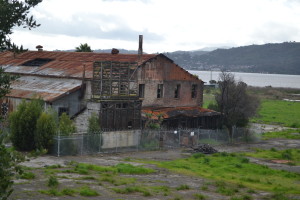
Members of the Historic Preservation Review Commission have appealed to save the historic Foundry and Office buildings at 678 East H St. from being demolished. The debate will be heard at tonight’s Building Code Board of Appeals meeting. (Photo by Nick Sestanovich)
The Building Code Board of Appeals will hear the appeal of the chief building official’s decision to issue an emergency demolition permit for two historic buildings at tonight’s meeting.
In October, the automobile import company Amports, filed an application for an emergency demolition permit to demolish the Foundry and Office buildings, located at 678 East H St. The buildings are designated historic landmarks, dating back to the 1850s when they were a shipping repair hub for the Pacific Mail Steamship Company. The buildings were previously owned by Yuba Industries, which at one point was one of the largest employers in the city, and many consider the area to be the first industrial park west of the Mississippi River. More than 30 years ago, the property was purchased by Amports, which still owns it today.
The buildings have seen structural damage over the decades, especially as a result of earthquake and fire damage. After receiving fire damage to the property in 2006, Amports applied to have the sites demolished, but the application was struck down by the Historic Preservation Review Commission. The site received further fire damage in 2015, and an evaluation was conducted and prepared by Chris Gale of 4 LEAF Inc. on Dec. 17 of that year. A different evaluator, 4 LEAF’s Chief Business Official Fred Cullum, provided an update on Dec. 20, 2016. The inspection uncovered numerous structural issues, including a collapsed roof, a rotted floor above the basement, rotted structural floor framing, several sections of a brick wall with no mortar remaining, corroded steel beams and more.
“These buildings (are) not going to stay ‘as it is’ and will continue to fall if nothing is done soon,” Gale said in his report.
“These buildings have historical significance to Benicia, and it is regrettable to lose them,” Cullum said in his executive summary, “but the fact is that they are economically impossible to save and, as attractive nuisances, present a hazard to trespassers and first responders.”
Chief Building Official Rachel O’Shea, who had previously red-tagged the buildings to prevent entry or occupancy, reviewed the application as well as city code and determined that the permit be issued. Members of the Historic Preservation Review Commission filed an appeal, arguing that the action would not be exempt from the California Environmental Quality Act and that the city violated its CEQA guidelines by not preparing an Environmental Impact Report.
The appellants cited the 1979 appellate court case of Neel Rich v. City of Benicia, in which “the city was found to have violated its own CEQA guidelines by not preparing an EIR for a project that could result in a significant adverse change to a historic resource,” in this case, the Crooks Mansion.
“The city lost this case and subsequently lost a second case, resulting in the city paying the attorney’s fees of the appellant,” the appellants wrote.
In regards to the first point, the appellants noted that, per CEQA guidelines, an EIR must be prepared for the demolition of a historic building because the demolition of a historic resource can not be mitigated. The appellants also contended— among other things— that the term “emergency” was being misapplied, the permit violated transparent government requirements and that owners of historic properties cannot be permitted to demolish their properties through neglect.
“These are among the last remaining monuments to the industrial expansion era,” the appellants wrote. “As the first industrial structures of this type built on the West Coast, these buildings contribute more than just a unique identity to the city of Benicia, they are state and federal resources.”
City staff did not agree that the permit violated CEQA guidelines, noting that the demolition was statutorily exempt from CEQA, noting that it does not apply to ministerial projects— i.e., governmental decisions that involve little or no personal judgment by the public official as to the wisdom or manner of carrying out the project— or projects where “specific actions (are) necessary to prevent or mitigate an emergency,” per Public Resources Code.
Staff agreed that they felt the applicant bore some responsibility for the deterioration of the structure, but trespassers who had vandalized the property and set fires were also involved.
“This code section refers to the obligation of owners of historic structures to maintain those structures,” O’Shea wrote, “but that does not mean that if the structures become hazardous, a demolition permit can’t be issued.”
O’Shea recommends adopting a resolution to deny the appeal and uphold the decision to issue the permit.
The meeting will be held at 6:30 p.m. tonight in the Dona Benicia Room of the Benicia Public Library, located at 150 East L St. For a full copy of the agenda, including the full application and appeal as well as other documents, visit http://www.ci.benicia.ca.us/agendas.






Leave a Reply